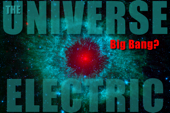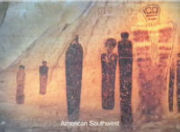Lucky It Ain't Rocket Science II - The Sequel (LIARS II)
01/10/2008
Another example of where the peer-review process has taken
us over the past 50 years of gravity-only cosmology, to the exclusion
of the Electric Universe.
My comments in [square brackets]
From New Scientist 10 January 2008
Middleweight black holes roam the galaxy undetected [Oxymoronic heading]
19:43 10 January 2008
NewScientist.com news service
David Shiga, Austin [again irreverently reviewed by David Smith]
Hundreds of middleweight black holes may rove unseen through the
galaxy [the lightweight and heavyweight one's stay put] after being
evicted from their homes [like rebellious teenagers] in star clusters,
according to calculations [of what, exactly?]. The black holes would
be almost impossible to spot, [almost?] explaining why they have
proven so elusive to find [if you ignore their non-existance].
Astronomers [mathematicians] have good evidence [have fudged the
figures] for the existence of small black holes about as massive
as the Sun, [four days ago you said small ones were about as massive
as a comet] and colossal ones with masses of millions or billions of
Suns. But observers [of math] have made only a few tentative detections
[or a few speculations] of intermediate-mass black holes (IMBHs),
weighing about 1000 Suns.
Different theories exist to explain the source of these middleweights,
[These middleweights are required to prop up our theory] but some astronomers
believe they grow from the mergers of stars and black holes [and I believe in
the underpants gnome - science should have no room for 'beliefs'] in the
densely packed [grey matter] centres of collections of stars called globular
clusters. About 150 globular clusters lie in and around the Milky Way galaxy
[we thought we'd throw a fact into the mix].
Now, new computer simulations [clearly more accurate than physical observatons]
may explain why so few globular clusters appear to host IMBHs. Kelly
Holley-Bockelmann of Vanderbilt University in Nashville, Tennessee, US, and
colleagues say the middleweight black holes get kicked out of their birthplaces
[by stuffy parents] to roam the galaxy unseen.
The study was motivated by [future funding prospects] recent groundbreaking
simulations [computer games] of mergers between black holes of different
masses or spin orientations. The merger generates powerful ripples in space
called gravitational waves [which LIGO have successfully non-detected] that
kick [with their gravity boots] the newly merged black hole away at speeds
of hundreds or even thousands of kilometres per second.
'Totally invisible' ['Totally unbelievable']
Holley-Bockelmann and her team realised that the kicks received when [our
funding arrived] middleweight black holes swallowed smaller neighbours could
eject them from globular clusters.
The team's simulations [The team's computer games] show that 70 to 98% of
the middleweight black holes at the hearts of clusters were ejected, depending
on the assumptions used, [it's ALL assumption] such as the mass of the small
black holes and the initial mass of the middleweight black hole [we have more
variables than you can poke a stick at].
Either way, it would mean a lot [more funding] of middleweight black holes are
wandering around our Milky Way galaxy [because we're surrounded by nasty globular
clusters all kicking them our way]. "There should be about 100 low-mass, rogue
[now these things can exercise free-will] intermediate mass black holes in the
Milky Way," Holley-Bockelmann says. "And unless they're accreting gas, they're
totally invisible." [They'll eat anything, surely they get gas?...]
If one of these itinerant black holes approached Earth, [we could put our heads
between our legs, and kiss ... the world goodbye] its gravity could potentially
disturb the orbits of comets [but not asteroids, planets or moons] and turn the
solar system into a shooting gallery. But Holley-Bockelmann says ["Woo-hoo! We
got the funding!"] the chances of one wandering close enough to do so are
vanishingly small [nil]. "We're not in any danger," she says [because she knows
it's all baloney].
Millions of orphans [Billions of dollars]
If most of the black holes really do get kicked out of their globular
clusters [I'll eat my hat], this could explain why searches have had such
difficulty finding them there [a search never found even one, anywhere].
There are no firm detections so far [I rest my case], but a globular cluster
called G1 is the best candidate for hosting [an Amway convention in space]
a middleweight black hole, based on [the figures we fudged to secure our
funding] the motion of stars at its centre, Holley-Bockelmann says.
Craig Wheeler of the University of Texas in Austin, US, who is not a member
of the team [who is smart enough not to own up], says it is still not known
whether middleweight black holes form in globular clusters in the first place
[says he doesn't believe a word of it, he's here for the pie]. But if they do,
the newly described effect could well kick many of them out to roam the galaxy
alone [and the underpants gnome could well eat my shorts].
He points out that the deaths of stars should also have littered our galaxy
with about 100 million smaller black holes [but we've never found one], each
a few times as massive as the Sun. "There are undoubtedly vastly more black
holes out there than we have observed," he told New Scientist ["1000x0=0,"
he told New Scientist].
The results were presented on Wednesday at a meeting of [the local comedy
club] the American Astronomical Society in Austin, Texas, US.
[end]
Yep, they sure are Lucky It Ain't Rocket Science (LIARS...)
Thanks again to New Scientist for making my task so easy
***No funding bodies were harmed during the writing of this parody***
Permalink to this article.
Public comment may be made on this article on the
Thunderbolts Forum/Thunderblogs (free membership required).
For a comprehensive central repository of links to study
Plasma Cosmology/Electric Universe please visit:
PlasmaResources.com
|

Dave Smith (davesmith_au) is an independent researcher and Managing
Editor of the Thunderblog.
My Archives
Chronological Archives
Archives by Author
Archives by Subject
Thunderblogs home
|




